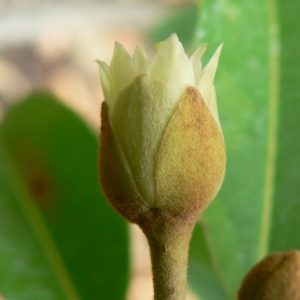Manilkara (Achras) zapota
Sapodilla, chiku
Origin
Native to Central America and now pantropical.
Climate
It is a tropical, semi-tropical species which grows within 30 degrees of the equator, with ideal precipitation of 1200-1800mm pa and a short dry period to stimulate flowering. It can only withstand light frosts when mature. A mean annual temperature of 26°C is favoured with minima and maxima of 15°C and 37°C respectively. They have some drought tolerance.
Plant Description
Chiku is an evergreen, low-branching, and long-lived, laticiferous tree, 5-15m tall when grafted, with a dense canopy and an extensive root system. The glossy leaves, elliptical and spiral, pointed at both ends, 5-15cm long, are clustered towards the ends of shoots with short internodes.
Relatives
Sapotaceae Family, related to abiu, canistel, star apple, mamey sapote, green sapote.
Soils
Undemanding if soil is well-drained, from sands to heavy clays and calcareous soils.
Propagation
Dry seeds store well and germinate easily but seedling growth is very slow; trees and fruit vary considerably. Most plants are self-grafted but cuttings can also be used. Because of the copious latex, the rootstock is cut twice; the first allows dissipation of the latex and the second is then used for the actual graft.
Cultivars
Cultivars include Prolific, Sawo Manila, Krasuey and Makok, a dwarf variety.
Flowering and Pollination
Hermaphrodite flowers are small, 8-12mm, with 3 outer and 3 inner sepals surrounding a pale green-white tubular corolla and 6 stamens. They are borne on short pedicels from the leaf base cluster. Flowering occurs mainly during summer. A dry period can induce flower bud formation and favours reproductive rather than vegetative growth. With anthesis, flowers emit a strong scent and the stigma is covered with sticky fluid. Cross-pollination by insects, mainly thrips, is often necessary but fruit set can be improved by hand-pollination. Some cvs appear self-fertile.
Cultivation
They should be planted in full sun. Young trees will need shading for the first year and regular watering for establishment. Producing plants will need irrigation if there is a dry period following fruit set and during fruit maturation. Two to three applications of NPK fertilizer should be given each year.
Wind Tolerance
This is exceptional and trees sometimes serve double purposes – producing fruit and serving as a windbreak for more sensitive species.
Pruning
Formation pruning will be required with young trees to encourage a strong scaffold of lateral branches. With mature trees the tasks are removal of any dead wood, skirting, size maintenance by rotating heading cuts and importantly, tipping to maximise the number of fruit-bearing branch terminals.
The Fruit
This is a pendulous round, conical or ovoid berry, 5-10cm wide and 100-400g. The smooth thin skin is covered with a light brown scurf and flesh is yellowish to light brown. If picked when immature it is astringent with copious latex, which vanishes when ripe to give a very sweet juicy smooth or sometimes grainy textured taste. There can be 0-12 shiny black oblong seeds. Compared to other fruit it has good levels of Ca and Fe, with carbohydrate content 20-25%.
Fruit Production and Harvesting
Seedlings may take 4-6 years to fruit; grafted trees can bear in half this time. A well-managed 10-year-old tree can produce 30-100kg of fruit pa. Fruit take 7-9 months to mature and have an extended harvest season. The brown skin colour does not change with maturity so a common way of gauging maturity is to lightly scratch the surface; if it’s still green it’s not ready and if it has turned yellowish it can be picked. Fruit should be handled carefully as they bruise easily. At room temperature they ripen and will become slightly soft in 3-7 days. Storage in a crisper for more than a few days will result in chill injury.
Fruit Uses
Normally eaten fresh by scooping out the flesh. It is also dried and used in yoghurt, ice cream, jam and jellies. Many volatiles central to flavours are lost when cooked. Historically, the latex was used as a base for chewing gum.
Pests and Diseases
Aphids, scales Medfly and leaf rust may sometimes need controlling but generally minimal problems.
Comments
This plant has lots going for it – good aesthetics, delicious and bountiful fruit, wind and drought tolerance and minimal maintenance. Make sure you obtain a grafted plant as these are more likely to be self-fertile and highly productive, plus you won’t have to wait as long for your reward. Medfly could cause you problems.



